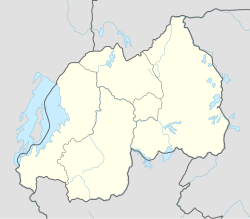Nyundo, Rubavu
| Nyundo | |
|---|---|

Nyundo mission in 1901
|
|
| Coordinates: 1°42′02″S 29°19′39″E / 1.700571°S 29.327488°ECoordinates: 1°42′02″S 29°19′39″E / 1.700571°S 29.327488°E | |
| Country | Rwanda |
| Province | Western |
| District | Rubavu |
| Sector | Nyundo |
| Climate | Aw |
Nyundo is a community in the Rubavu District of Western Province, Rwanda, on the Sebeya River to the east of Gisenyi. It is the location of one of the first Catholic missions to be established in Rwanda, and today is the headquarters of the Roman Catholic Diocese of Nyundo.
Nyundo is in Kanama commune, beside the Rubavu commune, and contains a seminary, schools and the residence of the bishop. It is about 12 kilometres (7.5 mi) to the east of Gisenyi, which is on the northeast shore of Lake Kivu.
German forces occupied Rwanda in 1897. In 1899 the White Fathers missionary John Joseph Hirth traveled to that country. There he tried to develop a relationship with King Yuhi Musinga. Hirth gained permission to found the first Catholic missions in Rwanda at Save, Zaza and Nyundo between 1900 and 1901. The church felt that if the king and the Tutsi ruling class of Rwanda were converted, the rest of the population would automatically accept the Catholic faith, so they focused their effort on the Tutsis.
The Nyundo mission was founded on 4 April 1901. The German colonial authority established an important base at Kisenyi, in alliance with the Tutsi elite, and the missionaries at Nyundo found themselves obliged to take the side of the Tutsis. When Hutu Christians took action against Tutsi exactions, the priests were blamed for causing this insubordination. The local Tutsi rulers also resented the missionaries, with their growing power and demands.
The mission was badly damaged during World War I, since it was close to the important defensive line between German and Belgian territory. The German forces lived off the land, and when they retreated in 1916 they first destroyed banana groves that could provide supplies to their opponents. The local people, who had gone into hiding, were unable to sow their crops. When the priests returned they were able to feed about two hundred people at the mission, but many more starved. Malnutrition was followed by outbreaks of smallpox, cerebrospinal menengitis and dysentery. Despite large-scale vaccinations by the fathers, more than two thousand people died in July 1918 alone.
...
Wikipedia

